| |
Book:
- Computational
and Network Modeling of Neuroimaging Data.
Edited by K. Kay. [link]
Pre-prints:
-
In vivo reconstruction of Duvernoy's
postmortem vasculature images. bioRxiv
(2025). [link]
- Hierarchical Processing of Natural Scenes
in the Human Pulvinar. bioRxiv
(2025). [link]
- Motion-corrected
eye tracking (MoCET) improves gaze
accuracy during visual fMRI experiments.
bioRxiv (2025). [link]
- A 7T fMRI dataset of
synthetic images for
out-of-distribution modeling of
vision. arXiv (2025). [link]
- Disentangling
signal and noise in neural responses through
generative modeling. bioRxiv
(2024). [link]
- The
Algonauts Project 2023 Challenge: How the
Human Brain Makes Sense of Natural Scenes.
arXiv (2023). A.T. Gifford, B. Lahner,
S. Saba-Sadiya, M.G. Vilas, A. Lascelles, A.
Oliva, K. Kay, G. Roig, R.M. Cichy. [link]
- The
need for validation in layer-specific fMRI.
OSF Preprints (2022). Merriam, E.,
Gulban, O.F., Kay, K. [link]
- Semantic
scene descriptions as an objective of human
vision. arXiv (2022). Doerig,
A., Kietzmann, T.C., Allen, E., Wu, Y.,
Naselaris, T., Kay, K., Charest, I. [link]
- The
Algonauts Project 2021 Challenge: How the
Human Brain Makes Sense of a World in
Motion. arXiv (2021). R.M.
Cichy, K. Dwivedi, B. Lahner, A. Lascelles, P.
Iamshchinina, M. Graumann, A. Andonian, N.A.R.
Murty, K. Kay, G. Roig, A. Oliva. [link]
|
PAPERS IN THE LAB'S MAIN
INTERESTS
2024
 |
A
Large-Scale Examination of
Inductive Biases Shaping
High-Level Visual Representation
in Brains and Machines.
Nature Communications (2024).
Conwell,
C., Prince, J.S., Kay, K.N.,
Alvarez, G.A., Konkle, T.
Journal
link
Deep
neural network models have been
found to be 'predictive' of
brain representations. To better
interpret this outcome, we
systematically vary properties
of how these models are designed
and assess which properties are
critical for predictivity. We
find that the visual diet
(stimuli used to train the
models) plays a critical role in
model predictivity.
|
 |
Principles of intensive human
neuroimaging. Trends in
Neurosciences (2024).
Kupers,
E.R., Knapen, T., Merriam, E.P.,
Kay, K.N.
Journal
link
We
provide a perspective on the
rise of 'intensive' neuroimaging
datasets that strive for
extensive sampling of cognitive
phenomena to support
computational modeling and
detailed investigation of brain
function at the single voxel
level. These datasets open new
paths of scientific discovery,
and naturally complement machine
learning and artificial
intelligence techniques.
|
 |
Driving and
suppressing the human language
network using large language
models. Nature Human
Behaviour (2024).
Tuckute,
G., Sathe, A., Srikant, S.,
Taliaferro, M., Wang, M.,
Schrimpf, M., Kay, K., Fedorenko,
E.
Journal
link
This
study develops predictive models
for a large fMRI dataset
targeting linguistic
representations elicited by
individual sentences. As a
demonstration of the
generalization power of these
models, synthetic sentences
predicted to either strongly
drive or suppress fMRI responses
are shown to indeed produce
these very effects.
|
2023
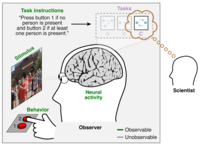 |
Tasks and
their role in visual
neuroscience. Neuron (2023).
Kay, K.,
Bonnen, K., Denison, R.N., Arcaro,
M.J., Barack, D.L.
Journal
link
In
this review, we offer a broad
perspective on the concept of
tasks, review the diverse ways
that tasks impact neural
activity in the visual system,
and outline an approach for the
formal modeling of tasks.
|
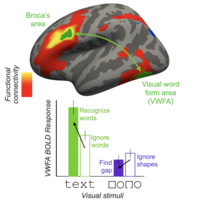 |
Engaging in word recognition
elicits highly specific
modulations in visual cortex.
Current Biology (2023).
White,
A.L., Kay, K., Tang, K.A.,
Yeatman, J.D.
Journal
link
Task
demands can affect visually
evoked responses. Here, we find
highly specific task effects in
visual word form area (VWFA).
Using a tightly controlled
paradigm, we demonstrate
enhancement of responses in VWFA
when the subject is directed to
perform a lexical decision task
on visually presented words.
These effects do not occur in
nearby cortical regions nor do
they occur in a closely matched
control task.
|
2022
 |
Improving the accuracy of
single-trial fMRI response
estimates using GLMsingle.
eLife (2022).
Prince,
J.S., Charest, I., Kurzawski,
J.W., Pyles, J.A., Tarr, M., Kay,
K.N.
Journal
link
Functional
MRI data suffer from limited
signal-to-noise ratio. Here we
describe an analysis toolbox,
termed GLMsingle, that
incorporates several techniques
to deliver improved estimates of
fMRI responses at the
single-trial level. Using
several existing fMRI datasets
as examples, we demonstrate
substantial downstream benefits
that are of interest to
cognitive and systems
neuroscientists. GLMsingle is
freely available at
glmsingle.org.
|
 |
Mesoscopic in
vivo human T2* dataset acquired
using quantitative MRI at 7
Tesla. NeuroImage
(2022).
Gulban,
O.F., Bollmann, S., Huber, R.,
Wagstyl, K., Goebel, R., Poser,
B.A., Kay, K.*, Ivanov, D.*
Journal
link
Increasing
the spatial resolution of
neuroimaging is critical for
improving our understanding of
the relationship between
macroscopic and microscopic
brain measurements. Here, we
present and release high-quality
mesoscopic quantitative T2*
measurements of the living human
brain. We show these
measurements exhibit clear
structures such as cortical
layers and intracortical
vessels, indicating the utility
of these data for further
investigations.
|
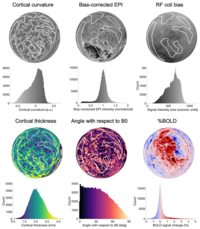 |
Non-Neural Factors Influencing
BOLD Response Magnitudes within
Individual Subjects. Journal
of Neuroscience (2022).
Kurzawski, J.W., Gulban, O.F.,
Jamison, K., Winawer, J.*, Kay,
K.*
Journal
link
Valid
interpretation of fMRI data
requires understanding physical
units and what they might
signify. Here, we study possible
non-neural contributions to
variation in percent BOLD signal
change (%BOLD) across primary
visual cortex. Such variations
are very large and found
consistently across different
datasets.
|
 |
The risk of
bias in data denoising methods:
examples from neuroimaging.
PLoS ONE (2022).
Kay, K.
Journal
link
Denoising
methods can seemingly improve
data quality, but it is
important to carefully think
about the possibility of bias.
Here, we review classic
statistical concepts of bias and
variance and provide simple
simulations (with accompanying
code) demonstrating these
concepts in examples drawn from
neuroimaging. The results
provide insight into the nature
of denoising.
|
 |
A massive 7T
fMRI dataset to bridge cognitive
neuroscience and artificial
intelligence. Nature
Neuroscience (2022).
Allen,
E.J., St-Yves, G., Wu, Y.,
Breedlove, J.L., Prince, J.S.,
Dowdle, L.T., Nau, M., Caron, B.,
Pestilli, F., Charest, I.,
Hutchinson, J.B., Naselaris, T.*,
& Kay, K.*
Journal
link
In
each of 8 carefully screened
participants, we sample
responses to 9,000–10,000
distinct natural scenes over the
course of 30–40 7T fMRI scan
sessions. We also develop novel
estimation and denoising methods
to improve the accuracy of
single-trial response estimates.
This neuroimaging resource
emphasizes extensive sampling of
individuals to better understand
cognitive function.
See also News
and Views by Botch, Roberston,
& Finn
|
2021
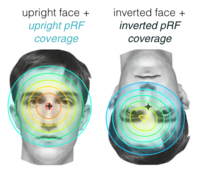
|
Holistic
face recognition is an emergent
phenomenon of spatial processing
in face-selective regions. Nature
Communications (2021).
Poltoratski, S., Kay, K., Finzi,
D., & Grill-Spector, K.
Journal
link | PDF
Here,
we perform systematic fMRI
measurements to upright and
inverted faces varying in
spatial position and find
systematic shifts in
face-selective regions of human
visual cortex. We then link
these effects to variations in
perceptual performance across
the visual field. The results
highlight the critical
dependence of both neural
representation and behavioral
performance on the precise
positioning of stimuli relative
to fixation.
|

|
Extensive
sampling for complete models of
individual brains. Current
Opinion in Behavioral Sciences
(2021).
Naselaris, T., Allen, E., &
Kay, K.
Journal
link | PDF
An
argument for why we should
collect extensive amounts of
data on a small number of
subjects, as opposed to modest
amounts of data on many
subjects.
|
2020

|
Fractional
Ridge Regression: a Fast,
Interpretable Reparameterization
of Ridge Regression.
GigaScience (2020).
Rokem, A.
& Kay, K.
Pubmed
link | Journal
link | PDF
Ridge
regression is a useful
statistical technique for
solving regression models. Here,
we improve its application by
showing how to better
parameterize (and therefore
estimate) its hyperparameter.
MATLAB and Python code toolboxes
are provided.
|
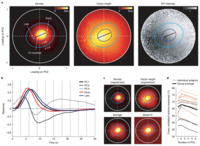
|
A
temporal decomposition method
for identifying venous effects
in task-based fMRI. Nature
Methods (2020).
Kay, K.,
Jamison, K.W., Zhang, R.-Y.,
Ugurbil, K.
Pubmed
link | Journal
link | PDF
fMRI
temporal dynamics contain
information regarding underlying
vascular sources of the fMRI
signal. Here, we develop a new
algorithm and associated code
toolbox that helps to estimate
and therefore isolate the
contributions of large
macrovessels.
|
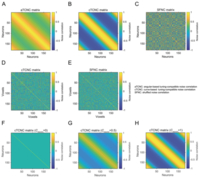
|
Understanding multivariate brain
activity: evaluating the effect
of voxelwise noise correlations
on population codes in
functional magnetic resonance
imaging. PLoS
Computational Biology
(2020).
Zhang,
R.-Y., Wei, X.-X., Kay, K.
Pubmed
link | Journal
link | PDF
The
consequence of 'noise
correlations' has been
heavily studied at the
level of single neurons,
but little explored at the
population level accessible via
functional neuroimaging. We
provide some theoretical
considerations for how these
effects may manifest in fMRI
data.
|
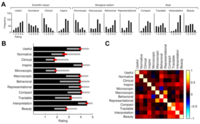
|
Appreciating
the variety of goals in
computational neuroscience.
Neurons, Behavior, Data
analysis, and Theory (2020).
Kording,
K.P., Blohm, G., Schrater, P.,
& Kay, K.
Journal
link | PDF
In
this opinion piece, we argue
that computational modeling is a
rich exercise that can be used
and applied in many different
ways. An informal survey of
computational researchers
reveals that this is indeed the
case. Thus, we should adopt an
flexible, open mind when
thinking about and evaluating
computational work.
|

|
Flexible
top-down modulation in human
ventral temporal cortex. NeuroImage
(2020).
Zhang,
R.-Y. & Kay, K.
Pubmed
link | Journal
link | PDF
Here,
we reanalyze a previously
acquired fMRI dataset to provide
further evidence of the complex
way in which top-down
modulations can manifest in
visual cortex, when probed with
sufficiently demanding and
complex perceptual tasks. The
results point to the need for
general and comprehensive models
that can account for a wide
range of observations.
|
2019
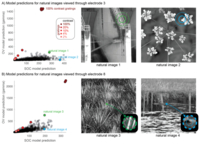
|
An
image-computable model for the
stimulus selectivity of gamma
oscillations. eLife
(2019).
Hermes,
D., Petridou, N., Kay, K.*, &
Winawer, J.*
Pubmed
link | Journal
link | PDF
The
presence of gamma oscillations
in neural signals have been
intriguing in terms of their
source and relevant for brain
function. We develop an
image-computable model that
helps formalize and characterize
the nature of these effects; the
model is based on high levels of
orientation variance.
|
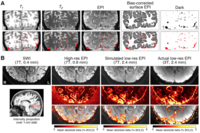
|
A
critical assessment of data
quality and venous effects in
sub-millimeter fMRI. NeuroImage
(2019).
Kay, K.,
Jamison, K.W., Vizioli, L., Zhang,
R., Margalit, E., & Ugurbil,
K.
Pubmed
link | Journal
link | PDF
Sub-millimeter
fMRI is a novel technique that
pushes the boundaries of what is
possible with fMRI. In this
detailed assessment, we
investigate and characterize the
nature of sub-millimeter fMRI
data including the substantial
(and potentially unwanted)
influence of the brain's
vasculature on the data, and
discuss the practical
implications of these issues.
|
2018

|
The
HCP 7T Retinotopy Dataset:
Description and pRF Analysis.
Journal of Vision (2018).
Benson,
N., Jamison, K.W., Arcaro, M.J.,
Vu, A., Glasser, M.F., Coalson,
T.S., Van Essen, D., Yacoub, E.,
Ugurbil, K., Winawer, J.*, &
Kay, K.*
Pubmed
link | Journal
link | PDF
Here
we describe a freely available,
very large 7T fMRI retinotopic
mapping dataset (n = 181), and
document basic analyses of the
data that indicate the data's
robustness and quality.
|
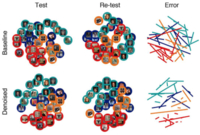
|
GLMdenoise
improves multivariate pattern
analysis of fMRI data. NeuroImage
(2018).
Charest,
I., Kriegeskorte, N., & Kay,
K.
Pubmed
link | Journal
link | PDF
We
evaluate the previously
introduced GLMdenoise technique
in terms of its consequence for
MVPA- and RSA-flavor analyses,
and demonstrate sizable
improvements in data quality.
|

|
Principles
for models of neural information
processing. NeuroImage
(2018).
Kay, K.N.
Pubmed
link | Journal
link | PDF
In
this perspective piece, we lay
out basic principles for how one
might approach building models
of neural information processing
and why current deep neural
network models of the brain may
not necessarily satisfy these
principles.
|

|
Cognitive
Computational Neuroscience: A
New Conference for an Emerging
Discipline. Trends in
Cognitive Sciences (2018).
Naselaris, T., Bassett, D.S.,
Fletcher, A.K., Kording, K.,
Kriegeskorte, N., Nienborg, H.,
Poldrack, R.A., Shohamy, D., &
Kay, K.
Pubmed
link | Journal
link | PDF
This
paper describes the motivation
and goals of a new annual
conference (CCN), and reports
thoughts and observations that
arose at the inaugural event.
|

|
Compressive
Temporal Summation in Human
Visual Cortex. Journal
of Neuroscience (2017).
Zhou, J.,
Benson, N.C., Kay, K., &
Winawer, J.
Pubmed
link | Journal
link | PDF
Analogous
to compressive summation across
the visual field, this paper
measures and demonstrates
compressive summation over time
and how this effect
systematically varies across
different visual areas.
|
2017

|
Binocular
Rivalry: A Window into Cortical
Competition and Suppression.
Journal of the Indian
Institute of Science
(2017).
Zhang,
R., Engel, S.A., & Kay, K.
Journal
link | PDF
A
review of the phenomenon of
binocular rivalry.
|

|
Defining
the most probable location of
the parahippocampal place area
using cortex-based alignment and
cross-validation. NeuroImage
(2017).
Weiner,
K., Barnett, M.A., Witthoft, N.,
Golarai, G., Stigliani, A., Kay,
K.N., Gomez, J., Natu, V.S.,
Amunts, K., Zilles, K.,
Grill-Spector, K.
Pubmed
link | Journal
link | PDF
A
systematic investigation of
identifying the location of PPA
and its consistency across
distinct individuals.
|

|
Bottom-up
and top-down computations in
word- and face-selective cortex.
eLife (2017).
Kay, K.N.
& Yeatman, J.D.
Pubmed
link | Journal
link | PDF
| PDF
(Figure Supplements)
Here,
we tackle the nature of
representation and the influence
of top-down modulation in
high-level visual areas (FFA and
VWFA). Using systematic
manipulations of stimulus type
and the task performed by the
observer, we identify and build
a computational model of
bottom-up and top-down effects.
The model is simple, principled,
and interpretable, and accounts
for clear effects observable in
the data.
|
2015

|
Resolving
ambiguities of MVPA using
explicit models of
representation. Trends
in Cognitive Sciences
(2015).
Naselaris, T. & Kay, K.N.
Pubmed
link | Journal
link | PDF
We
describe a few limitations of
traditional MVPA approaches to
analyzing functional brain
activity, and suggest the value
of building explicit models of
representation.
|
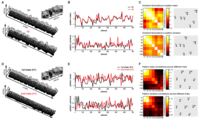
|
Visual
representations are dominated by
intrinsic fluctuations
correlated between areas. NeuroImage
(2015).
Henriksson, L., Khaligh-Razavi,
S., Kay, K., & Kriegeskorte,
N.
Pubmed
link | Journal
link | PDF
We
show the very large impact of
'noise correlations' on
representational similarity
analysis of fMRI data, and
demonstrate a simple analysis
that can remove these effects.
|

|
Attention
reduces spatial uncertainty in
human ventral temporal cortex.
Current Biology (2015).
Kay,
K.N., Weiner, K.S., &
Grill-Spector, K.
Pubmed
link | Journal
link | PDF
(Main text + Supplemental)
We
demonstrate selectivity for
visual space in face-selective
visual regions, estimate
population receptive fields
(pRFs) at the voxelwise level,
and show how pRFs are affected
by the task performed by the
observer. We conclude that the
representation of space is a
critical component of the
ventral stream and that a full
understanding of visual
representations must take into
account the cognitive state of
the observer.
|
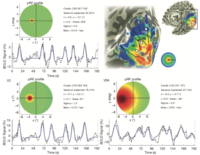
|
Computational
modeling of responses in human
visual cortex. In:
Brain Mapping: An Encyclopedic
Reference, edited by P. Thompson
& K. Friston (2015).
Wandell,
B.A., Winawer, J., & Kay, K.N.
Journal link
| PDF
Here
we review and provide a
perspective on using
computational modeling to
understand basic aspects of
representation in human visual
cortex.
|
2013

|
GLMdenoise:
a fast, automated technique for
denoising task-based fMRI data.
Frontiers in Neuroscience
(2013).
Kay,
K.N., Rokem, A., Winawer, J.,
Dougherty, R.F. & Wandell,
B.A.
Pubmed
link | Journal
link | PDF
We
present a simple, principled
denoising algorithm for
task-based fMRI based on
combining data-driven noise
derivation and cross-validation.
The algorithm is demonstrated on
a variety of datasets and is
packaged into a MATLAB code
implementation.
|

|
Asynchronous
broadband signals are the
principal source of the BOLD
response in human visual cortex.
Current Biology (2013).
Winawer,
J., Kay, K.N., Foster, B.L.,
Rauschecker, A.M., Parvizi, J.,
& Wandell, B.A.
Pubmed
link | Journal
link | PDF
(Main text) | PDF
(Supplemental Information)
Using
a controlled visual paradigm, we
identify two distinct aspects of
electrocorticographical (ECoG)
signals and show that
'broadband' asynchronous
responses most closely match
what is observed in fMRI BOLD
signals.
|
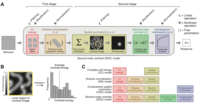
|
A
two-stage cascade model of BOLD
responses in human visual
cortex. PLoS
Computational Biology
(2013).
Kay,
K.N., Winawer, J., Rokem, A.,
Mezer, A., & Wandell, B.A.
Pubmed
link | Journal
link | PDF
Using
carefully controlled stimuli, we
develop a two-stage hierarchical
cascade model of linear and
nonlinear computations that
underlie visually evoked
responses in early and
intermediate cortex. The model
indicates the prominent role of
second-order contrast
computations in extrastriate
visual regions.
|

|
Compressive
spatial summation in human
visual cortex. Journal
of Neurophysiology (2013).
Kay,
K.N., Winawer, J., Mezer, A.,
& Wandell, B.A.
Pubmed
link | Journal
link | PDF
(Main text) | PDF
(Supporting Information)
We
demonstrate the existence of
sub-additive spatial summation
in fMRI BOLD responses in many
visual areas, and propose a
simple nonlinearity into a
population receptive field (pRF)
model to accommodate this
observation. The nonlinearity is
shown to vary systematically
across visual areas and can be
interpreted as a means by which
visual responses gain tolerance
for changes in the position and
size of objects.
|
2011
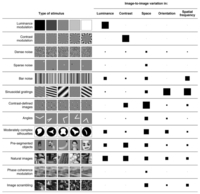
|
Understanding visual
representation by developing
receptive-field models. In:
Visual Population Codes: Towards
a Common Multivariate Framework
for Cell Recording and
Functional Imaging, edited by N.
Kriegeskorte & G. Kreiman
(2011).
Kay, K.N.
Book
link | PDF
Here
we provide a perspective on why
understanding visual
representation is challenging
and how explicit
image-computable models can help
tackle these challenges.
|
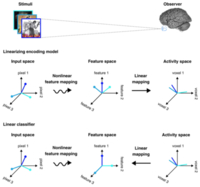
|
Encoding
and decoding in fMRI. NeuroImage
(2011).
Naselaris,
T., Kay, K.N., Nishimoto, S. &
Gallant, J.L.
Pubmed
link | Journal
link | PDF
In
this review, we provide a
framework for understanding how
different 'encoding' and
'decoding' fMRI studies are
related to one another. The
notion of a 'feature space' is
introduced, which is one way to
help clarify the similarities
and differences therein.
|
2009
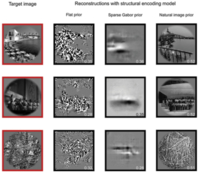
|
Bayesian
reconstruction of natural images
from human brain activity. Neuron
(2009).
Naselaris,
T., Prenger, R.J., Kay, K.N.,
Oliver, M. & Gallant, J.L.
Pubmed
link | Journal
link | PDF
(Main text) | PDF
(Supplementary Information)
Here
we demonstrate a method for
decoding the stimulus viewed by
an observer based on brain
activity. We introduce the idea
of putting priors on the
stimulus distribution and
include a method for
incorporating information
conveyed in high-level visual
areas.
|

|
I can see
what you see. Nature
Neuroscience (2009).
Kay,
K.N. & Gallant, J.L.
Pubmed
link | Journal
link | PDF
We
comment on Miyawaki et al.,
Neuron, 2008 and put it into
historical context.
|
2008

|
Identifying
natural images from human brain
activity. Nature
(2008).
Kay,
K.N., Naselaris, T., Prenger, R.J.
& Gallant, J.L.
Pubmed
link | Journal
link | PDF
(Main text) | PDF
(Supplementary Information)
| Commentary
Using
extensive sampling of many
natural images shown to the
observer during fMRI scanning,
this paper develops an 'encoding
model' approach in which an
explicit image-computable model
(based on Gabor filters) is
proposed to characterize how
voxels in early visual cortex
represent the viewed image.
After building this model, it is
then demonstrated that the model
is accurate enough such that the
specific image viewed by an
observer can be identified with
high accuracy based solely on
the brain activity elicited by
the image.
|
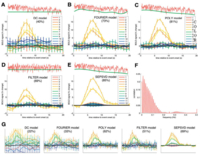
|
Modeling
low-frequency fluctuation and
hemodynamic response timecourse
in event-related fMRI.
Human Brain Mapping
(2008).
Kay,
K.N., David, S.V., Prenger, R.J.,
Hansen, K.A. & Gallant, J.L.
Pubmed
link | Journal
link | PDF
Here
we evaluate and demonstrate
methods for estimating
timecourses and signal drifts in
event-related fMRI, with an
emphasis on precision at the
single voxel level.
Cross-validation is shown as a
means for controlling
overfitting.
|
2007

|
Topographic
organization in and near human
visual area V4. The Journal of
Neuroscience (2007).
Hansen,
K.A., Kay, K.N. & Gallant,
J.L.
Pubmed
link | Journal
link | PDF
Novel
retinotopic mapping stimuli and
techniques are used to map early
and intermediate human visual
cortex using fMRI. Based on the
resulting maps, a proposal for
V4 in human visual cortex is
made.
|
|
|
COLLABORATIVE PAPERS
2025
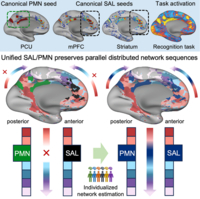 |
Situating the salience and
parietal memory networks in the
context of multiple parallel
distributed networks using
precision functional mapping.
Cell Reports (2025).
Kwon,
Y.H., Salvo, J.J., Anderson, N.L.,
Edmonds, D., Holubecki, A.M.,
Lakshman, M., Yoo, K., Yeo B.T.T.,
Kay, K., Gratton, C., Braga, R.M.
Journal
link
|
2024
 |
The human
social cognitive network
contains multiple regions within
the amygdala. Science
Advances (2024).
Edmonds,
D., Salvo, J.J., Anderson, N.,
Lakshman, M., Yang, Q., Kay, K.,
Zelano, C., Braga, R.M.
Journal
link
|
 |
Frontostriatal salience network
expansion in individuals in
depression. Nature
(2024).
Lynch,
C.J., Elbau, I., Ng, T., Ayaz, A.,
Zhu, S., Wolk, D., Manfredi, N.,
Johnson, M., Chang, M., Chou, J.,
Summerville, I., Ho, C., Lueckel,
M., Bukhari, H., Buchanan, D.,
Victoria, L.W., Solomonov, N.,
Goldwaser, E., Moia, S.,
Caballero-Gaudes, C., Downar, J.,
Vila-Rodriguez, F., Daskalakis,
Z.J., Blumberger, D.M., Kay, K.,
Aloysi, A., Gordon, E.M., Bhati,
M.T., Williams, N., Power, J.D.,
Zebley, B., Grosenick, L.,
Gunning, F.M., Liston, C.
Journal
link
|
 |
Semantic plasticity across
timescales in the human brain.
eLife reviewed preprint (2024).
Solomon,
S.H., Kay, K., Schapiro, A.C.
Journal
link
|
 |
Stacked regressions and
structured variance partitioning
for interpretable brain maps.
NeuroImage (2024).
Lin, R.,
Naselaris, T., Kay, K., Wehbe, L.
Journal
link
|
 |
Improved quantitative parameter
estimation for prostate T2
relaxometry using convolutional
neural networks. Magnetic
Resonance Materials in Physics,
Biology and Medicine (2024).
Bolan,
P.J., Saunders, S.L., Kay, K.,
Gross, M., Akcakaya, M., Metzger,
G.J.
Journal
link
|
 |
Modeling short visual events
through the BOLD moments video
fMRI dataset and metadata.
Nature Communications (2024).
Lahner,
B., Dwivedi, K., Iamshchinina, P.,
Graumann, M., Lascelles, A., Roig,
G., Gifford, A.T., Pan, B., Jin,
S., Murty, N., Kay, K., Oliva,
A.*, Cichy, R.*
Journal
link
|
 |
Natural
scenes reveal diverse
representations of 2D and 3D
body pose in the human brains.
PNAS (2024).
Zhu, H.*,
Ge, Y.*, Bratch, A., Yuille, A.,
Kay, K., Kersten, D.
Journal
link
|
2023
 |
Better models of human
high-level visual cortex emerge
from natural language
supervision with a large and
diverse datasets. Nature
Machine Intelligence (2023).
Wang,
A.Y., Kay, K., Naselaris, T.,
Tarr, M.J., Wehbe, L.
Journal
link
Here,
we demonstrate improvements in
modeling fMRI activity based on
neural network models that are
trained on language-based
descriptions of visual inputs.
The results suggest a close
connection between the
processing of visual inputs in
the brain and the extraction of
linguistic information from
visual inputs.
|
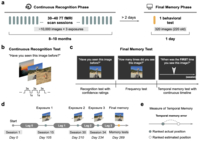 |
Re-expression of CA1 and
entorhinal activity patterns
preserves temporal context
memory at long timescales.
Nature Communications (2023).
Zou, F.,
Guo, W., Allen, E.J., Wu, Y.,
Charest, I., Naselaris, T., Kay,
K., Kuhl, B.A., Hutchinson, J.B.*,
DuBrow, S.*
Journal
link
We
exploit the Natural Scenes
Dataset which provides a unique
look at neural activity as
humans store and recall memories
across long timescales. Evidence
is shown for the encoding of
temporal context in the
hippocampus and entorhinal
cortex.
|
 |
Brain-optimized deep neural
network models of human visual
areas learn non-hierarchical
representations. Nature
Communications (2023).
St-Yves,
G., Allen, E.J., Wu, Y., Kay, K.*,
Naselaris, T.*
Journal
link
Deep
neural network models have been
entertained as possible models
of biological visual systems.
Here, we examine the common
presumption that the
hierarchical structure of such
models reflects an important
facet of computation in brains.
Using the Natural Scenes
Dataset, we demonstrate
brain-optimized models that
predict brain activity well but
do not reflect straightforward
hierarchical relationships. This
suggests deeper and more precise
characterizations are necessary
to understand the connection
between brains and models.
|
2022
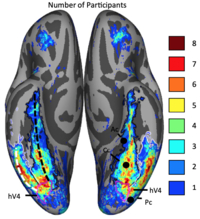 |
Color-biased regions in the
ventral visual pathway are food
selective. Current
Biology (2022).
Pennock,
I.M.L., Racey, C., Allen, E.J.,
Wu, Y., Naselaris, T., Kay, K.N.,
Franklin, A., Bosten, J.M.
Journal
link
Color-biased
regions have been reported in
the ventral visual stream. Here,
we use exploit the rich sampling
present in the Natural Scenes
Dataset to investigate the
representational properties of
these regions. We find that both
color and form independently
contribute to increased activity
in these regions. In particular,
these regions appear to be
preferentially activated by
images with food content, even
for images with low color
saturation.
|
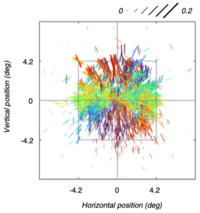 |
Natural scene sampling reveals
reliable coarse-scale
orientation tuning in human V1.
Nature Communications (2022).
Roth,
Z.N., Kay, K.*, Merriam, E.P.*
Journal
link
Here,
we leverage the large-scale
Natural Scenes Dataset to
estimate voxel-level orientation
tuning using model-based methods
that compensate for vignetting
(or edge) effects. Results
demonstrate clear evidence for
coarse-scale orientation
representational biases in
primary visual cortex.
|
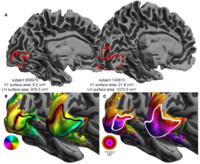 |
Variability of the Surface Area
of the V1, V2, and V3 Maps in a
Large Sample of Human Observers.
Journal of Neuroscience (2022).
Benson,
N.C., Yoon, J., Forenzo, D.,
Engel, S.A., Kay, K.N., Winawer,
J.
Journal
link
Using
the freely available Human
Connectome Project 7T Retinotopy
Dataset, we trained human
"anatomists" to manually define
the size and extent of visual
areas V1, V2, and V3. The
results enable us to demonstrate
a very wide range of sizes (up
to 3.5x) of these early visual
areas across healthy young
adults. These results indicate
the challenge of comparing and
combining measures of brain
structure and function across
individuals.
|
 |
Multiple traces and altered
signal-to-noise in systems
consolidation: Evidence from the
7T fMRI Natural Scenes Dataset.
PNAS (2022).
Vanasse,
T.J., Boly, M., Allen, E.J., Wu,
Y., Naselaris, T., Kay, K.,
Cirelli, C., Tononi, G.
Journal
link
To
study systems-level memory
consolidation, we leverage the
longitudinal large-scale Natural
Scenes Dataset measuring
recognition performance for
images over the course of nearly
a year. We find that the medial
temporal lobe contribution to
recognition persists over 200
days, supporting multiple-trace
theory.
|
 |
NeuroGen:
activation optimized image
synthesis for discovery
neuroscience. NeuroImage
(2022).
Gu, Z.,
Jamison, K.W., Khosla, M., Allen,
E.J., Wu, Y., St-Yves, G.,
Naselaris, T., Kay, K., Sabuncu,
M.R., Kuceyeski, A.
Journal
link
Visual
representations of naturalistic
scenes in the brain are rich and
complex. Here, a computational
framework is developed that uses
optimization to generate
synthetic stimuli designed to
achieve specific targeted
activations in the brain. This
technique may prove useful for
controlling brain activity and
generating hypotheses about
visual representations.
|
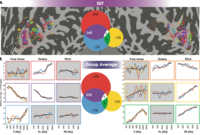 |
Distinct
representations of tonotopy and
pitch in human auditory cortex.
Journal of Neuroscience
(2022).
Allen,
E., Mesik, J., Kay, K., Oxenham,
A.
Journal
link
Using
7T fMRI and carefully controlled
stimuli, we identify auditory
cortical regions that reflect
pitch per se, as opposed to
simpler forms of spectral
content.
|
2021
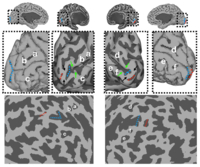 |
The
retrocalcarine sulcus maps
different retinotopic
representations in macaques and
humans. Brain Structure
and Function (2021).
Arcaro,
M.J., Livingstone, M.S., Kay,
K.N., & Weiner, K.S.
Journal
link
Careful
examination of functional
neuroanatomy reveals that
specific sulci in occipital
cortex are predictive of
retinotopic representations
within species, but diverge
substantially across species.
This observation places
constraints on theories of
structure-function
relationships.
|
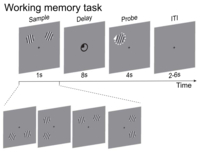 |
Sensory recruitment revisited:
Ipsilateral V1 involved in
visual working memory. Cerebral
Cortex (2021).
Zhao, Y.,
Kay, K.N., Tian, Y., & Ku, Y.
Pubmed
link | Journal
link
Here,
we use fMRI and a visual working
memory task to demonstrate
evidence for ipsilateral cortex
in maintaining visual working
memory representations.
|

|
Emerging
ethical issues raised by highly
portable MRI research in remote
and resource-limited
international settings. NeuroImage
(2021).
Shen,
F.X., Wolf, S.M., Bhavnani, S.,
Deoni, S., Elison, J.T., Fair, D.,
Geethanath, S., Garwood, M., Gee,
M.S., Kay, K., Lim, K.O., Estrin,
G.L., Luciana, M., Peloquin, D.,
Rommelfanger, K., Schiess, N.,
Siddiqui, K., Torres, E., &
Vaughan, J.T.
Pubmed
link | Journal
link | PDF
The
prospects of portable MRI
scanners open new avenues of
possibilities in research,
clinical, and everyday
applications.
|
2020
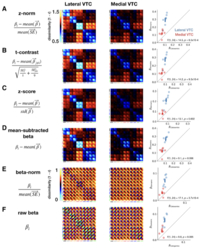
|
Ultra-high-resolution
fMRI of Human Ventral Temporal
Cortex Reveals Differential
Representation of Categories and
Domains. The Journal of
Neuroscience (2020).
Margalit,
E., Jamison, K.W., Weiner, K.S.,
Vizioli, L., Zhang, R.-Y., Kay,
K.N.*, & Grill-Spector, K.*
Pubmed
link | Journal
link | PDF
We
use high-resolution 7T fMRI to
probe the nature of stimulus
representations in ventral
temporal cortex, and find a
medial-lateral distinction with
respect to how categories and
domains are represented.
|
2019

|
Predicting
neuronal dynamics with a delayed
gain control model. PLoS
Computational Biology
(2019).
Zhou, J.,
Benson, N.C., Kay, K., &
Winawer, J.
Pubmed
link | Journal
link | PDF
The
temporal dynamics of neural
responses to simple
presentations of stimuli show
complex behaviors. Here we
develop a simple unified
computational model that can
account for a wide range of
these phenomena.
|
2018

|
Foreground-background
segmentation revealed during
natural image viewing. eNeuro
(2018).
Papale,
P., Leo, A., Cecchetti, L.,
Handjaras, G., Kay, K., Pietrini,
P., & Ricciardi, E.
Pubmed
link | Journal
link | PDF
Using
image-computable models applied
to perturbed versions of the
original input stimuli, this
study investigates the nature of
foreground and background
representation in visual cortex.
|
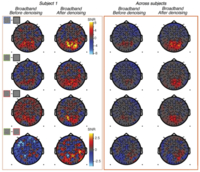
|
A
non-invasive, quantitative study
of broadband spectral responses
in human visual cortex. PLOS
One (2018).
Kupers,
E.R., Wang, H.X., Amano, K., Kay,
K.N., Heeger, D.J., & Winawer,
J.
Pubmed
link | Journal
link | PDF
Here
we introduce a new EEG denoising
method that aids in the
measurements of broadband
responses in EEG.
|
2017

|
The
Functional Neuroanatomy of Human
Face Perception. Annual
Review of Vision Science
(2017).
Grill-Spector, K., Weiner, K.S.,
Kay, K., & Gomez, J.
Pubmed
link | Journal
link | PDF
A
review of the anatomical and
functional properties of human
visual cortex that subserve the
perception of faces.
|
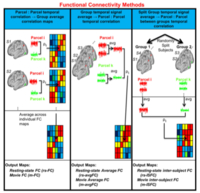
|
A
new modular brain organization
of the BOLD signal during
natural vision. Cerebral
Cortex (2017).
Kim, D.,
Kay, K., Shulman, G., &
Corbetta, M.
Pubmed
link | Journal
link | PDF
Using
both resting-state and
movie-watching fMRI data, this
paper applies connectivity
analyses to characterize the
network architecture of
macroscopic brain areas observed
at rest and during naturalistic
stimulation.
|
2011

|
Encoding
and decoding V1 fMRI responses
to natural images with sparse
nonparametric models. Annals
of Applied Statistics
(2011).
Vu,
V.Q., Ravikumar, P., Naselaris,
T., Kay, K.N., Gallant, J.L. &
Yu, B.
Pubmed link | Journal link | PDF
Using
V1 fMRI responses as an example
data scenario, we demonstrate
statistical techniques that
enable the learning of flexible
nonlinearities in large-scale
regression models.
|
2009

|
Nonparametric
sparse hierarchical models
describe V1 fMRI responses to
natural images. In: Advances in Neural
Information Processing Systems
21, edited by D. Koller, D.
Schuurmans, Y. Bengio, & L.
Bottou (2009).
Ravikumar,
P., Vu, V.Q., Yu, B., Naselaris,
T., Kay, K.N. & Gallant, J.L.
Book
link | PDF
A
demonstration of sparse additive
models to improve encoding-model
performance in V1.
|
|
|
|